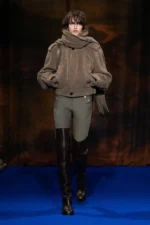Milan’s PAC Museum of Contemporary Art became the stage for Tod’s Fall/Winter 2025 collection, where art met fashion in a celebration of resilience and human skill. Guests entering the venue were greeted by a striking sight: Carla Bruni, perched on a pedestal, draped in a sculptural recycled leather dress by artist Nelly Agassi, clutching an oversized needle-a symbolic nod to the artisans at the heart of Tod’s identity. The moment distilled the vision of owner Diego Della Valle, who has long championed craftsmanship as irreplaceable even in an age of automation.
Creative director Matteo Tamburini, now in his third season, has refined his sharp yet fluid aesthetic for Fall/Winter 2025. Inspired by the museum’s history-a 1950s structure rebuilt after a 1993 bombing-he reflected themes of rebirth and heritage. Italian artists such as Carla Accardi and Lucio Fontana influenced his approach, not through literal references, but through their tactile experimentation with materials. The result was a collection that felt both grounded and futuristic, combining precision with warmth.

Outerwear dominated with confidence. A brushed alpaca coat in black and white swirls echoed Accardi’s abstract canvases, while structured mohair double-breasted jackets featured subtly offset buttons for a modern twist. Leather trenches, including a belted iteration worn by Irina Shayk, showcased Tod’s mastery of supple hides. Tamburini emphasized texture, pairing ribbed knits with plush shearling and layering cashmere capes over leather-lined peacoats. Silhouettes were elongated, often cinched at the waist to accentuate shape without rigidity.
Shoes reimagined classics. The iconic gommino sole appeared in napped python, while the W.G. ankle boot evolved into a brushed Chelsea style. Riding boots, tall and sleek, balanced practicality with polish. Bags followed suit: the Di Bag Folio featured artistic patchwork, and the Wave bag was lighter, its slouchiness softened to complement the collection’s fluidity.
Della Valle’s insistence on “artisanal intelligence” resonated throughout. From Agassi’s installation to Tamburini’s meticulous fabric treatments, the message was clear: human hands remain indispensable. Machines may replicate stitches, but they cannot replicate the intuition behind a perfectly draped hem or the choice of alpaca brushed to mimic stormy skies.
Tamburini’s minimalism avoids sterility. Olive-green cashmere capes cascaded over coats, and asymmetrical hems on sleeveless dresses introduced movement. “I wanted surfaces to speak,” he remarked, and they did-whispering luxury through every texture. The collection felt like a quiet revolution, proving that restraint can be eloquent.
©Photo: Tod’s

















































